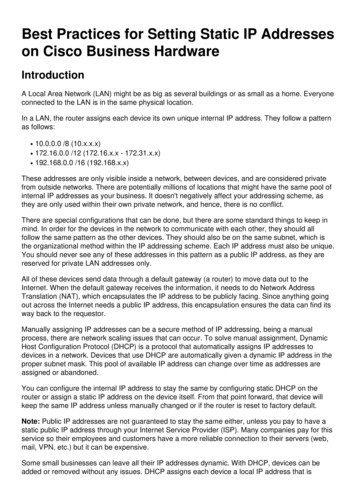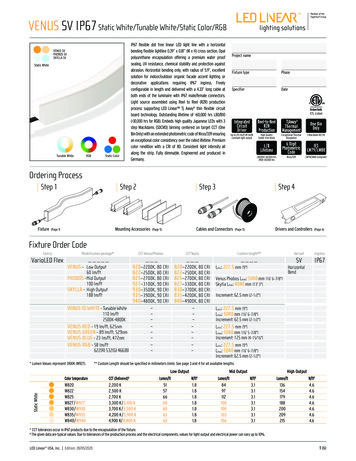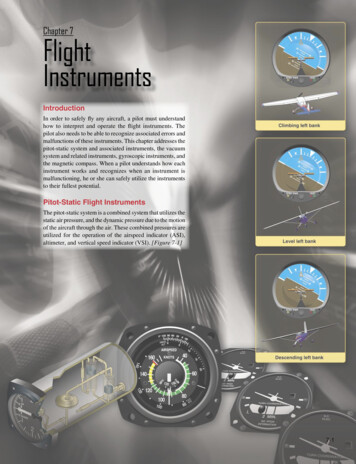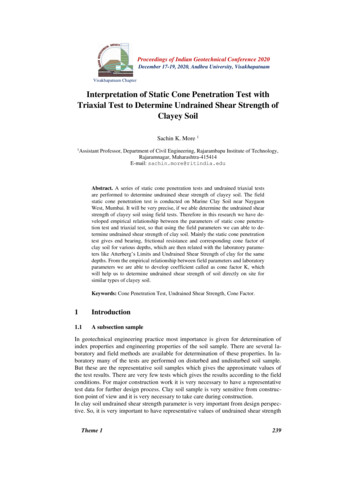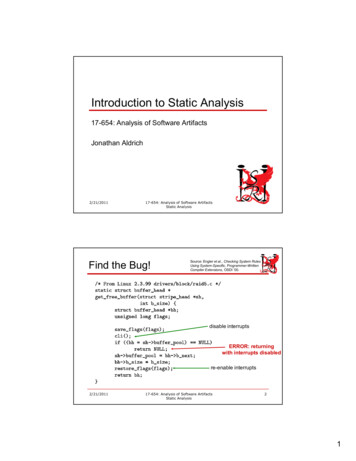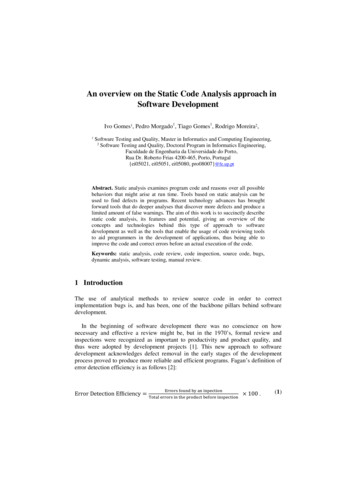
Transcription
Introduction to Static Equipment inOil and Gas IndustryOperations Petrochemicals, Oil and Gas Facebook GroupFree WebinarBAHER ELSHEIKHJULY 2020
Career Timeline2002 - 2008Cairo Oil Refining CompanyMechanical Design Engineer2008 - 2016MethanexBaher ElsheikhMechanical EngineerStatic Equipment SpecialistSenior Mechanical Engineer2016 - PresentSabic - SafcoSenior Mechanical EngineerCertificationsAPI 580Risk Based InspectionAPI 571Damage Mechanisms in Fixed EquipmentPublicationsThermal Cycling Damage in Reformer TubesNitrogen Syngas 2016 (CRU) – March 2016Effective Reliability and Safety Management of Steam Reformer TubesNACE Conference – Jubail - 2019CRESteam Reformer Tubes; Lifecycle and Integrity ManagementCertified Reliability EngineerStainless Steel World Magazine – March, 2020CRLComprehensive Integrity Management Program for Reformer TubesCertified Reliability LeaderInspectioneering Journal – April, 2020Collar Bolts in Shell and Tube Heat ExchangerHeat Exchanger World Magazine – May, 2020Baher Elsheikh @
STATIC EQUIPMENT IN OIL AND GAS INDUSTRYMute your device, switch off your cameraQuestions and open discussions at end of the sessionAnswer all the questions and get freecopy of all references used in thepresentation plus copy of presentationQ1GroundRulesQ 10Notice this sign, marked information can be used incase study at endWe will focus on some parts and others will providedfor referenceSTATIC EQUIPMENT IN OIL AND GAS INDUSTRYOPERATIONS OIL AND GAS FACEBOOK GROUP – FREE WEBINARBAHER ELSHEIKH – JULY 2020
STATIC EQUIPMENT IN OIL AND GAS INDUSTRYMain Areas of knowledge for technical static equipmentengineer in operating companiesMain static equipment in oil and gas industryMaterials, heat treatment and corrosionContentsStresses and mechanical design of static equipmentCodes and StandardsCase Study on Shell and Tube Heat ExchangerSTATIC EQUIPMENT IN OIL AND GAS INDUSTRYOPERATIONS OIL AND GAS FACEBOOK GROUP – FREE WEBINARBAHER ELSHEIKH – JULY 2020
Static Equipment Engineer – Areas of KnowledgeKnowledge PoolCompetent Qualified Static EngineerSTATIC EQUIPMENT IN OIL AND GAS INDUSTRYOPERATIONS OIL AND GAS FACEBOOK GROUP – FREE WEBINARBAHER ELSHEIKH – JULY 2020
Main Static EquipmentQ1How to differentiatebetween pressurevessel, shell and tubeheat Exchanger andDeaerator at sitePressure VesselsSTATIC EQUIPMENT IN OIL AND GAS INDUSTRYHeat ExchangersDeaeratorOPERATIONS OIL AND GAS FACEBOOK GROUP – FREE WEBINARBAHER ELSHEIKH – JULY 2020
Main Static EquipmentQ2Which of the 3equipment requiresfrequent temperaturemonitoring bypyrometer and why?Steam Reformer and FiredHeatersSTATIC EQUIPMENT IN OIL AND GAS INDUSTRYSecondary ReformerReactors and ConverterOPERATIONS OIL AND GAS FACEBOOK GROUP – FREE WEBINARBAHER ELSHEIKH – JULY 2020
Main Static EquipmentQ3How RGB differs fromFired Boiler and whatare the commonaspectsFired BoilerReformed Gas / Waste Heat BoilerSTATIC EQUIPMENT IN OIL AND GAS INDUSTRYHRSGOPERATIONS OIL AND GAS FACEBOOK GROUP – FREE WEBINARBAHER ELSHEIKH – JULY 2020
Main Static EquipmentQ4What is the main differencebetween storage tanks andpressure vesselsStorage TanksSTATIC EQUIPMENT IN OIL AND GAS INDUSTRYPiping SystemsValves and PRVsOPERATIONS OIL AND GAS FACEBOOK GROUP – FREE WEBINARBAHER ELSHEIKH – JULY 2020
MaterialsSTATIC EQUIPMENT IN OIL AND GAS INDUSTRYOPERATIONS OIL A ND GAS FACEBOOK GROUP – FREE WEBINARBAHER ELSHEIKH – JULY 2020
Material litySTATIC EQUIPMENT IN OIL AND GAS INDUSTRYBrittlenessOPERATIONS OIL AND GAS FACEBOOK GROUP – FREE WEBINARBAHER ELSHEIKH – JULY 2020
Classification of dDeoxidationPracticeMicrostructureSuch asSuch assuch assuch assuch asCarbon SteelOpen hearthHot RollingRequiredStrengthHeatTreatmentAs specified inASTMSuch asAnnealingFerritickilledHigh strengthLow AlloySteelsBasic OxygenProcess,Cold lectricFurnacemethodsTemperingPearliticRimmed steelIntermediatestrengthQuenchingLow strengthSource: ASM Handbook, Volume 1, Properties and Selection:Irons, Steels, and High Performance AlloysSTATIC EQUIPMENT IN OIL AND GAS INDUSTRYOPERATIONS OIL AND GAS FACEBOOK GROUP – FREE WEBINARBAHER ELSHEIKH – JULY 2020
Plain Carbon Steel Mo for Creep ResistanceGrade 11/2 Mo SteelsThickness RequiredFrom Differnt Grades ofCr-Mo SteelSteam Pipe temperature600 C, pressure 30MPa Cr & Mo for Creep ResistanceGrade 11 (1Cr-0.5 Mo)Grade 22 (2.25Cr-1 Mo)CreepResistanceCr-Mo LowAlloy Steels Cr for HydrogenAnd Corrosion ResistanceGrade 5 (5Cr-0.5 Mo)Grade 9 (9Cr-1 Mo) Nb, V & N for improvedCreep ResistanceGrades 91(0.1C-9Cr-1Mo-Nb-V-N) 1-2% W for even greaterCreep ResistanceGrade 92 (9Cr-0.5Mo-1.8W)Grade 911 (9Cr-1Mo-1W)Tungsten-Bearing (% Cr-SteelSOURCE: THE ALLOY TREE - J. C. M. FARRAR V for CreepResistance½ to 3% Chrome-MolyVanadium Steels0.5-3Cr;1Mo;0.25 V1Grades 23 & 24 B2.5Cr–1Mo–0.25V–B–TiGrades X20(0.2 C-12Cr-1Mo-0.5W-0.3V)Grades HCM12A/122Advanced 12% Cr steels0.C-11Cr-Nb-V-N(up to 3Co)BAHER ELSHEIKH
Shaeffler Diagram (A-austenite; M – Martensite; F – ferrite)Stainless steel familiesStainless Steel FamiliesAusteniticStainless SteelsThis group contains at least 16% chromium and 6% nickel(the basic grade 304 is referred to as 18/8Ferritic StainlessSteelsPlain chromium (10.5 to 18%) grades such as Grade 430 and409Duplex StainlessSteelsHave microstructures comprising a mixture of austenite andferrite. Duplex ferritic. Examples : 2205 and 2304MartensiticStainless SteelsChromium as the major alloying element but with a highercarbon and generally lower chromium content (e.g. 12% inGrade 410 and 416) than the ferritic typesPH StainlessSteelsSTATIC EQUIPMENT IN OIL AND GAS INDUSTRYChromium and nickel containing steels that can develop veryhigh tensile strengths. The most common grade in this groupis "17-4 PH"OPERATIONS OIL AND GAS FACEBOOK GROUP – FREE WEBINARBAHER ELSHEIKH – JULY 2020
Reative Mechanical and Physical Properties of Stainless SteelTypical Tensile PropertiesThermal Expansion and Thermal ConductivityTypical Impact PropertiesSTATIC EQUIPMENT IN OIL AND GAS INDUSTRYOPERATIONS OIL AND GAS FACEBOOK GROUP – FREE WEBINARBAHER ELSHEIKH – JULY 2020
sition Temp.References:- API 579-1 Part 9- ASM Handbook volume 11 - Failure analysis and prevention- ASME BPVC Sec. VIII Div.1 - UCS 66- API 650STATIC EQUIPMENT IN OIL AND GAS INDUSTRYOPERATIONS OIL AND GAS FACEBOOK GROUP – FREE WEBINARBAHER ELSHEIKH – JULY 2020
Dissimilar Metal WeldDMWReferences:AWS – Welding Handbook, Volume 4 Part 1
Austenitic Stainless-Steel302BSi added toincreasescalingresistanceS30200317More Mo andCr added forbettercorrosionresistanceS31700317LC reduced forbetterweldingcharacteristicS31703317LMNMo addedN added319309S316Mo addedto increasecorrosionresistanceS31600Cr and Niincreased forheat resistanceS30900S30905316LC reducedfor betterweldedcorrosionresistanceS31603310310SMore Cr andNi for betterheat 00N and MnPartlyreplace NiS20200205201N and Mnpartlyreplace NiS20500N and Mnpartlyreplace NiS20100308302Higher Crand Ni usedprimarily forWeldingS30800Higher C forincreasedstrength347Nb and Taadded tooppose CrCarbidesprecipitationS34700316LN314348C reduced;N added toincreasestrengthS31653Si increasedfor highestheatresistanceS31400Ta and Corestrictedfor nuclearapplicationsS34800316F316NS and P addedto improvemachinabilityS31620N added toincreasestrengthS31651S30200321304LTi added tooppose CrCarbidesprecipitationS32100C reduced orfurther bettercorrosionresistance inwelded partsS30403304N304LNN added toincreasestrengthS30451N added toincreasestrengthS30453305Niincreasedto lowerworkhardeningS30500384More Ni tolower workhardeningS38400Magnetic XNi Cr 301303S added toimprovemachinabilityS30300303SeSe added forbettermachinedsurfacesS30323Cr and Nilowered toincreaseworkhardeningS30100- Corrosion Resistance- good mechanicalpropertiesSuitable for HighTemp. Application- Susceptible to Cl SCCand pitting- Lower oxidationresistance – prone tooxide spallingS304430Cu addedto improvecoldworkingS30430Al: AluminumC: CarbonCr: ChromiumCb: ColumbiumCo: CobaltCu: CopperMn: ManganeseMo: MolybdenumN: NitorgenNi: NickelP: PhosphorousS: SulfurSe: SeleniumSi: SiliconTa: TantalumTi: TitaniumV: VanadiumW: TungstenSource: ASM- Stainless Steel for Design EngineersSTATIC EQUIPMENT IN OIL AND GAS INDUSTRYOPERATIONS OIL AND GAS FACEBOOK GROUP – FREE WEBINARBAHER ELSHEIKH – JULY 2020
Austenitic Stainless-SteelScaling ResistanceQ5Why the Max. Temp. for intermittent service is less thanthe allowed for continuous service in Austenitic SSSource: NiDi- High Temperature Characteristics of Stainless SteelsSTATIC EQUIPMENT IN OIL AND GAS INDUSTRYOPERATIONS OIL AND GAS FACEBOOK GROUP – FREE WEBINARBAHER ELSHEIKH – JULY 2020
Ferritic Stainless Steel430General PurposeMagnetic Ni XCr increasedto improvescalingresistance442Crincreased toimprovescalingresistanceC reduced,Mo added toimprovecorrosionresistance; Tiand Nb addedSlightly lessCr for betterWeldabilityC reduced;Ti added toopposecarbideprecipitationS44200S44400Lower Cr;Primarilyused forautomotiveexhaustsystemsS40900P and Sincreased toimprovemachinabilityS43020S44600Lower CR, Aladded topreventhardeningwhen cooledfrom elevatedtemperaturesS40500Mo added forimprovedcorrosionresistance inautomotivetrimS43400446S42900S43035430F SeAl: AluminumC: CarbonCr: ChromiumCb: ColumbiumCo: CobaltCu: CopperMn: ManganeseMo: MolybdenumN: NitorgenNi: NickelP: PhosphorousS: SulfurSe: SeleniumSi: SiliconTa: TantalumTi: TitaniumV: VanadiumW: TungstenSe added forbettermachinedsurfacesS43023- Not Suitable for HighTemp. Application(subject to 475embrittlement)436Mo, Nb andTa added forcorrosion andheatresistanceS43600Source: ASM- Alloying, Understanding the BasicsSTATIC EQUIPMENT IN OIL AND GAS INDUSTRYOPERATIONS OIL AND GAS FACEBOOK GROUP – FREE WEBINARBAHER ELSHEIKH – JULY 2020
Martensitic Stainless Steel410GeneralPurposeS41000431414403420Cr increased and Niadded for bettercorrosionresistance, goodmechanicalpropertiesS43100Ni added forbettercorrosionresistanceS41400Select qualityfor turbinesand highlystressed partsS40300Cincreasedto improvemechanicalpropertiesS42000422Strength andtoughness to12000F viaaddition ofMo, V, WS41400416P and Sincreased toimprovemachinabilityS41600440CC increased forhighesthardness; Crincreased forcorrosionresistanceS44004416Se440BSe added forbetter machinedsurfacesS41623C decreasedslightly to improvetoughnessS44004420F440AP and Sincreased toimprovemachinabilityS42020C decreased evenmore than for440B to improvetoughnessS44002Magnetic Ni XCr -CorrosionResistance- Hardenable-Hard to weldAl: AluminumC: CarbonCr: ChromiumCb: ColumbiumCo: CobaltCu: CopperMn: ManganeseMo: MolybdenumN: NitorgenNi: NickelP: PhosphorousS: SulfurSe: SeleniumSi: SiliconTa: TantalumTi: TitaniumV: VanadiumW: TungstenSource: ASM- Alloying, Understanding the BasicsSTATIC EQUIPMENT IN OIL AND GAS INDUSTRYOPERATIONS OIL AND GAS FACEBOOK GROUP – FREE WEBINARBAHER ELSHEIKH – JULY 2020
Duplex Stainless SteelDuplex Stainless Steel50/50Austenite / FerriteMagnetic Ni Cr LeanDSSLower Ni, noMoStandardDSSHigher Ni, andMoSuperDSS25 Cr and higherNi, and MoHyperDSSMore Cr, Ni Ni,Mo and NS32101S31803S32520S32707S32202S2205- Not suitable forHigh Tapplications(subject to 011-CorrosionResistance- Pitting resistancein Cl service (HighPREN)- High strengthS82906S82441Al: AluminumC: CarbonCr: ChromiumCb: ColumbiumCo: CobaltCu: CopperMn: ManganeseMo: MolybdenumN: NitorgenNi: NickelP: PhosphorousS: SulfurSe: SeleniumSi: SiliconTa: TantalumTi: TitaniumV: VanadiumW: TungstenSource: API 938C, Use of DSS in Oil Refinery IndustrySTATIC EQUIPMENT IN OIL AND GAS INDUSTRYOPERATIONS OIL AND GAS FACEBOOK GROUP – FREE WEBINARBAHER ELSHEIKH – JULY 2020
Duplex Stainless SteelPREN %Cr 3.3Mo rce: API 938C, Use of DSS in Oil Refinery IndustrySTATIC EQUIPMENT IN OIL AND GAS INDUSTRYOPERATIONS OIL AND GAS FACEBOOK GROUP – FREE WEBINARBAHER ELSHEIKH – JULY 2020
Duplex Stainless SteelSource: API 938C, Use of DSS in Oil Refinery IndustrySTATIC EQUIPMENT IN OIL AND GAS INDUSTRYOPERATIONS OIL AND GAS FACEBOOK GROUP – FREE WEBINARBAHER ELSHEIKH – JULY 2020
Stainless SteelsAdd Fe50 Cr50NiAlloyAlloy 601Add Cr, lower Cfor resisting acidsAdd Cr, Al forresistance toOxidation acidsAlloy 690Add Mo, Cr forresistance,chlorides, andhigh TempenvironmentAdd Fe for economy and Cr forcarburization, oxidationresistanceAlloy600Ni-15Cr-8FeAdd Ti, Al forStrengtheningAlloyX-750Add Co, M,B, Zr, W, CbFor gas turbinerequirementsSource: ASM Corrosion of WeldmentsASM Stress Corrosion CrackingSTATIC EQUIPMENT IN OIL AND GAS INDUSTRYSuperalloysAdd Mo, Cu for Resistance toChlorides, reducing acidsAlloy 800, 800H, 802Add Cr, lowerC for resistingacidsAlloys625, C-276C-4, XAlloys825, GAlloysB, B-2Add Cr got highTemp strengthresistanceto oxidizing mediaAdd Mo forResistance toreducingacids,halogensAdd CuNickel200NickelAlloysAdd CuResistance RATIONS OIL AND GAS FACEBOOK GROUP – FREE WEBINARBAHER ELSHEIKH – JULY 2020
Materials Application – Carbon SteelCarbon Steel is widely used in oil and gas industry mainly due to its cost, availabilityand easy fabrication and welding.Limitations:Low corrosion resistance in many applicationsVery low temperature -29 C .CS loose toughnessHigh Temperature: 425 C . CS low creep strength, high oxidation rate, andsusceptibility to carburizationSusceptible to FAC in condensate serviceSTATIC EQUIPMENT IN OIL AND GAS INDUSTRYOPERATIONS OIL AND GAS FACEBOOK GROUP – FREE WEBINARBAHER ELSHEIKH – JULY 2020
Materials Application – Low Alloy Cr-Mo SteelLow alloy Chromium Molybdenum (Cr-Mo) Steels are replacing the Carbon steels as acandidate material where:- Temperature is higher than the maximum limits of carbon steels- In application where Hydrogen is present at relative high temperature and partialpressure to resist High Temperature Hydrogen Attack (HTHA)Common Grades:P11 (1.25 Cr- 0.5 Mo)P22 (2.5 Cr – 0.5 Mo)P5 (5 Cr- 0.5 Mo)P91 (9 Cr- 1 Mo)Note: Cr-Mo steel is usually require application of Post Weld Heat Treatment (PWHT)during fabrication or repair, which sometimes are difficult to apply at siteSTATIC EQUIPMENT IN OIL AND GAS INDUSTRYOPERATIONS OIL AND GAS FACEBOOK GROUP – FREE WEBINARSteam Pipetemperature 600 C,pressure 30MPaBAHER ELSHEIKH – JULY 2020
Materials Application – Stainless SteelStainless steels is a material of Cr 11 % where Cr formed the distinguishingsurface oxide layer of the stainless steels.Austenitic stainless steels is applied widely where:- Higher Corrosion resistance is required- Temperature is higher than the maximum limits of Cr-Mo Steels- Temperature is lower than the lower limit of CS to avoid brittle fracture andtoughness lossA main concern of austenitic SS is the susceptibility to pitting and cracking in Clservices, Where DSS is preferred for this aspectDuplex stainless steels limited for Temp. 316 C to avoid 475 embrittlementSTATIC EQUIPMENT IN OIL AND GAS INDUSTRYOPERATIONS OIL AND GAS FACEBOOK GROUP – FREE WEBINARBAHER ELSHEIKH – JULY 2020
Materials Application – Nickel Based AlloysNi Based alloys (Incoloy, Inconel, Monel, .) are replacing Stainless steels when:- Higher Corrosion resistance is required- Temperature is higher than the maximum limits of stainless Steels (oxidation, metal dusting, Nitriding,carburization,.)Ni Alloys are of much higher cost compared to stainless steels which limits its application.Alloys with Ni 42% is almost immune for chloride SCC. Alloy 825 (42% Ni) is often specified for applicationsrequiring resistance to chloride SCC.STATIC EQUIPMENT IN OIL AND GAS INDUSTRYOPERATIONS OIL AND GAS FACEBOOK GROUP – FREE WEBINARBAHER ELSHEIKH – JULY 2020
Materials Application – Refractory LinedRefractory lining is applied where the metals cannot withstand the operating temperature and / or toreduce the cost of the equipment by using lower design temperature and hence lower material gradeSTATIC EQUIPMENT IN OIL AND GAS INDUSTRYOPERATIONS OIL AND GAS FACEBOOK GROUP – FREE WEBINARBAHER ELSHEIKH – JULY 2020
Materials Application – Non Metallic Piping and VesselsNon metallic materials include wide range of different materials like: FRP, PVC, PE, Cement, lined equipmentUsually applied where corrosion resistance is requiredLimited in temperature applicationSpecial precautions ( Protection from UV, vent holes for PTFE lined, .)Preferred application for underground piping to have good corrosion resistance without need of CathodicProtectionSTATIC EQUIPMENT IN OIL AND GAS INDUSTRYOPERATIONS OIL AND GAS FACEBOOK GROUP – FREE WEBINARBAHER ELSHEIKH – JULY 2020
RecommendedReadings forSS and Ni C EQUIPMENT IN OIL AND GAS INDUSTRYOPERATIONS OIL AND GAS FACEBOOK GROUP – FREE WEBINARBAHER ELSHEIKH – JULY 2020
HeatTreatmentSTATIC EQUIPMENT IN OIL AND GAS INDUSTRYOPERATIONS OIL AND GAS FACEBOOK GROUP – FREE WEBINARBAHER ELSHEIKH – JULY 2020
Iron-Carbide Phase DiagramArea of FocusSTATIC EQUIPMENT IN OIL AND GAS INDUSTRYOPERATIONS OIL AND GAS FACEBOOK GROUP – FREE WEBINARBAHER ELSHEIKH – JULY 2020
Heat TreatmentAnnealing980Heat treatment with furnacecooling from Austenitizing rangeFor Hypoeutectoid steels (C 0.80%), full annealing consists ofheating to 90 to 180 C A3 temp.For Hypereutectoid steels (C 0.80%), heating above the A1temperature, followed by veryslow cooling.900Temperature, CAnnealing is used to reducehardness, obtain a relativelynear-stable microstructure,refine grain size, improvemachinability, and facilitate 740723 CA166058000.20.40.60.811.21.41.6Composition (wt, C)Reference: Heat Treating, Vol 4, ASM Handbook, ASM InternationalSTATIC EQUIPMENT IN OIL AND GAS INDUSTRYOPERATIONS OIL AND GAS FACEBOOK GROUP – FREE WEBINARBAHER ELSHEIKH – JULY 2020
Heat re, CSteelnormalizedby furnaceheatingHeatistreatmentwith160to 200 C intothe austenitecoolingfromAustenitizingrangephase field at temperaturessomewhatthoseAnnealing higheris usedthanto reduceusedby annealing,hardness,obtain afollowedrelativelybycoolingat a mediumrate (Airnear-stablemicrostructure,Coolingfor CS).refine grainsize, improvemachinability, and facilitate coldSteelsare normalized to establishworking.a uniform microstructure andrefinegrain size. steels (C For HypoeutectoidThefasterfullcoolingrate consistsresults inofa0.80%),annealingmuchfinerheatingto microstructure,90 to 180 C A3 whichtemp.is harder and stronger than thecoarsermicrostructureproducedFor Hypereutectoidsteels(C byfull annealing.0.80%),heating above the A1temperature, followed by veryslow 3740723 CA166058000.20.40.60.811.21.41.6Composition (wt, C)Reference: Heat Treating, Vol 4, ASM Handbook, ASM InternationalSTATIC EQUIPMENT IN OIL AND GAS INDUSTRYOPERATIONS OIL AND GAS FACEBOOK GROUP – FREE WEBINARBAHER ELSHEIKH – JULY 2020
Heat e900Temperature, CSteelnormalizedby furnaceheatingHeatistreatmentwithToproducea steelin itssoftest160to 200 ibleconditionwith minimumphasefieldat rthanthoseAnnealingandis usedto reduceithardness,canbybeannealing,spheroidizedby heatingusedbyobtain afollowedrelativelyjustabovejust belowcoolingat tectoidand thenCoolingfortemperatureCS).refine grainsize, improveholdingat that temperaturemachinability,and facilitate forcoldanextendedperiod oftotime.Steelsare normalizedestablishworking.a uniform microstructure andrefinegrain size. steels (C For HypoeutectoidThefasterfullcoolingrate consistsresults inofa0.80%),annealingmuchfinerheatingto microstructure,90 to 180 C A3 whichtemp.Ref.:Heat TreatingSubjectthanGuideisharderand strongertheASMcoarsermicrostructureproducedFor InternationalHypereutectoidsteels(C byfull annealing.0.80%),heating above the A1temperature, followed by veryslow 3740723 CA1SpheroidizationandStress Relief66058000.20.40.60.811.21.41.6Composition (wt, C)Reference: Heat Treating, Vol 4, ASM Handbook, ASM InternationalSTATIC EQUIPMENT IN OIL AND GAS INDUSTRYOPERATIONS OIL AND GAS FACEBOOK GROUP – FREE WEBINARBAHER ELSHEIKH – JULY 2020
Post Weld Heat Treatment When weld is applied it is molten metaland thermally expanded when filling agroove.Weld Metal HotBase Metal When weld metal cools, it will shrink alot. Yield Strength is low for much of thecooling range. Surrounding metal that was not heated tomolten temperatures will constrain orkeep the weld from shrinking as it cools.RestraintRestraint Post Weld Heat Treatment is a procedureto reduce residual stress, temper theHAZ, and remove hydrogen from the weldregion after a seam weld is made.STATIC EQUIPMENT IN OIL AND GAS INDUSTRYBase MetalOPERATIONS OIL AND GAS FACEBOOK GROUP – FREE WEBINARWeld Metal underTensionBAHER ELSHEIKH – JULY 2020
Post Weld Heat Treatment Weld and HAZ heated below the transition temperature for several hours and thengradually allowed to cool. Can Global (entire vessel) Can be Local (weld seam and surrounding metalQ6Recommended Readings: WRC 452STATIC EQUIPMENT IN OIL AND GAS INDUSTRYThink and AnswerWhat are the main pros and cons of each PWHTtechnique Global / LocalOPERATIONS OIL AND GAS FACEBOOK GROUP – FREE WEBINARBAHER ELSHEIKH – JULY 2020
CorrosionSTATIC EQUIPMENT IN OIL AND GAS INDUSTRYOPERATIONS OIL AND GAS FACEBOOK GROUP – FREE WEBINARBAHER ELSHEIKH – JULY 2020
CorrosionCorrosion a chemical or electrochemical reaction between a materialand its environment that produces a deterioration (change) of thematerial and its propertiesWhy do metals corrode?Most metals are found in nature as ores. The manufacturing process of converting theseores into metals involves the input of energy.During the corrosion reaction the energy added in manufacturing is released, and themetal is returned to its oxide state.Metal OreReduction (add Electron)MetalOxidation (strip electron)Corrosion ProductsCorrosion Consequence:1. Downtime2. Product Loss 3. Efficiency LossSTATIC EQUIPMENT IN OIL AND GAS INDUSTRY4. ContaminationOPERATIONS OIL AND GAS FACEBOOK GROUP – FREE WEBINAR5. OverdesignBAHER ELSHEIKH – JULY 2020
Corrosion Forms – Classic Fontana & Green FormsUniformCorrosionCorrosion attack that is more or less distributed over the entire exposed surface of a metal.GalvanicCorrosionaccelerated corrosion of a metal because of contact with a more noble metal in an itting CorrosionLocalized attack at and adjacent to grain boundaries, with relatively little corrosion of the grains, isintergranular corrosion. The alloy disintegrates (grains fall out) and/or loses its strength.a localized attack on a metal adjacent to a crevice between two joining surfaces (two metals or metalnonmetal crevices)a localized phenomenon confined to smaller areas. Pitting corrosion are normally found on passive metalsand alloysSelectiveLeachingRemoval of one element from a solid alloy by corrosion processes Examples are dezincification in on of metals and alloys due to relative movement between metal surfaces and corrosive fluids.Depending on the rate of this movement, abrasion takes place.Stress CorrosionCracking(SCC) refers to failure under simultaneous presence of a corrosive medium and a tensile stress.STATIC EQUIPMENT IN OIL AND GAS INDUSTRYOPERATIONS OIL AND GAS FACEBOOK GROUP – FREE WEBINARBAHER ELSHEIKH – JULY 2020
Uniform CorrosionUniform Corrosion is also called general corrosion. Thesurface effect produced by most direct chemical attacks(e.g., as by an acid) is a uniform etching of the metalControl Selection of a more corrosion resistant alloy (i.e.higher alloy content or more inert alloy) Utilize coatings to act as a barrier between metal andenvironment. Modify the environment or add chemical inhibitors toreduce corrosion rate. Apply cathodic protection. Replace with corrosion resistant non-metallicmaterial.Reference: Inspector Knowledge – Corrosion Basics, By Mok Check MinSTATIC EQUIPMENT IN OIL AND GAS INDUSTRYOPERATIONS OIL AND GAS FACEBOOK GROUP – FREE WEBINARBAHER ELSHEIKH – JULY 2020
Galvanic CorrosionGalvanic Corrosion is anelectrochemical action of twodissimilar metals in the presenceof an electrolyte and an electronconductive path.It occurs when dissimilar metalsare in contact.Control Use of galvanically compatiblematerials Avoid unfavorable area effectsof a small anode and largecathode Use of electrical insulationbetween dissimilar materialsSTATIC EQUIPMENT IN OIL AND GAS INDUSTRYOPERATIONS OIL AND GAS FACEBOOK GROUP – FREE WEBINARBAHER ELSHEIKH – JULY 2020
Intergranular CorrosionIntergranular corrosion is an attack on or adjacent to the grainboundaries of a metal or alloy. A highly magnified cross sectionof most commercial alloys will show its granular structure.This structure consists of quantities of individual grains, andeach of these tiny grains has a clearly defined boundary thatchemically differs from the metal within the grain center.Control Heat treatment of alloy to remove phases from grainboundary regions which reduce corrosion resistance (i.e.solution annealing). Use modified alloys which have eliminated such grainboundary phases through stabilizing elements or reducedlevels of impuritiesSTATIC EQUIPMENT IN OIL AND GAS INDUSTRYOPERATIONS OIL AND GAS FACEBOOK GROUP – FREE WEBINARBAHER ELSHEIKH – JULY 2020
Crevice CorrosionCrevice Corrosion is an intense localized corrosion frequentlyoccurs within crevices and other shielded areas on metal surfacesexposed to corrosives. This type of attack is usually associatedwith small volumes of stagnant solution caused by holes, gasketsurfaces, lap joints, surface deposits, and crevices under bolt andrivet headsControl Redesign of equipment to eliminate crevices. Close crevices with non-absorbent materials or incorporate abarrier to prevent of moisture penetration into crevice. Prevent or remove builds-up of scale or solids on surface. Use of one-piece or welded construction versus bolting orriveting. Select more corrosion resistant or inert alloyReference: NALCO Guide to Cooling Water System Failure AnalysisSTATIC EQUIPMENT IN OIL AND GAS INDUSTRYOPERATIONS OIL AND GAS FACEBOOK GROUP – FREE WEBINARBAHER ELSHEIKH – JULY 2020
Pitting CorrosionPitting is a form of extremely localized attack that results in holes inthe metal. These holes may be small or large in diameter, but in mostcases they are relatively small. Pits are sometimes isolated or so closetogether that they look like a rough surface.For stainless steels, pitting resistance equivalent number (PREN) is equalto:PREN Cr 3.3 (Mo 0.5 W) 16NControl Choose the material most appropriate for the service conditions Avoid stagnant zones and deposits Reduce the aggressivity of the medium (using inhibitors) Maintain the protective film of the material Use cathodic protection.STATIC EQUIPMENT IN OIL AND GAS INDUSTRYOPERATIONS OIL AND GAS FACEBOOK GROUP – FREE WEBINARBAHER ELSHEIKH – JULY 2020
Selective LeachingSelective Leaching is the removal of one element from a solid alloy bycorrosion processes. The most common example is the selective removal ofzinc in brass alloys (dezincification). Similar processes occur in other alloysystems in which aluminum; iron, cobalt, chromium, and other elementsare removedControl Select “inhibited” versions of copper alloys. Use alternative materials that are not susceptible to dealloying in theenvironment(s) Reduce severity of environment through environmental control oraddition of effective chemical inhibitors Cathodic protection Use of coating to act as a barrier between the environment and thealloySTATIC EQUIPMENT IN OIL AND GAS INDUSTRYOPERATIONS OIL AND GAS FACEBOOK GROUP – FREE WEBINARBAHER ELSHEIKH – JULY 2020
Erosion-CorrosionErosion-corrosion is a description for the damage that occurs whenparticle erosion and/or high flow velocity contributes to corrosion byremoving protective films or scales or otherwise accelerating thecorrosion rate.Control Changes in shape, geometry, and materials can help mitigate erosionand erosion-corrosion. Examples include increasing the pipediameter to reduce velocity Improved resistance to mechanical erosion is usually achieved byincreasing component hardness Heat exchangers utilize impingement plates and occasionally tubeferrules Ensure proper operation to avoid water droplets in the steamsystem. Use abrasion resistance coatingSTATIC EQUIPMENT IN OIL AND GAS INDUSTRYOPERATIONS OIL AND GAS FACEBOOK GROUP – FREE WEBINARBAHER ELSHEIKH – JULY 2020
Stress Corrosion CrackingSCC is Cracking caused by the simultaneous presence of tensile stressand a specific corrosive medium. Usually lead to unexpected suddenfailure.Examples: (Chloride SCC, Carbonate SCC, Caustic SCC, Ethanol SCC,HF SCC and Polythionic acid SCC)Control Use resistant materialProperly apply coating if applicableResidual stress release application when applicableDesign to avoid stagnant conditions of species causing SCCProper application of NDE and inspection techniques for earlydetection of cracksSTATIC EQUIPMENT IN OIL AND GAS INDUSTRYOPERATIONS OIL AND GAS FACEBOOK GRO
Fired Boiler . Reformed Gas / Waste Heat Boiler. ST AT I C EQ U I P MENT I N O I L AND G AS I NDU ST R Y O P ER AT I O NS O I L AND G AS FACEBO O K G R O U P - FR EE WEBI NAR BAHER ELSHEI KH - J U LY 2020. HRSG. How RGB differs from Fired Boiler and what are the common aspects . Q 3
